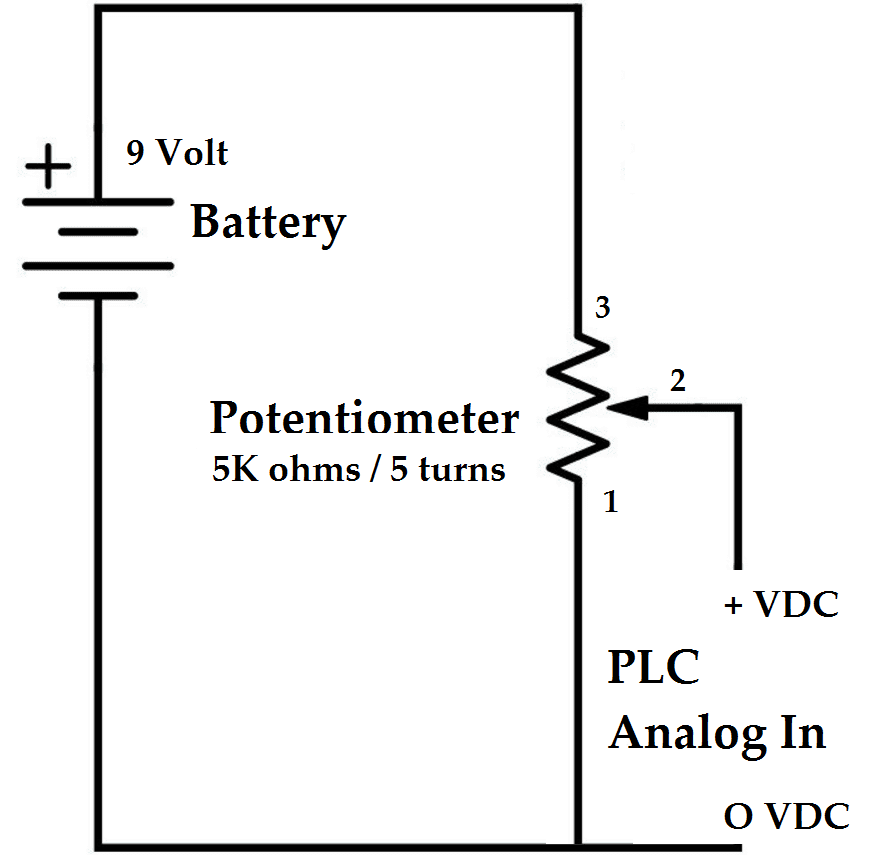We will create a simple and inexpensive analog voltage tester for a PLC using a potentiometer and a 9VDC battery. The potentiometer will be 5K ohms. This should be enough impedance for most analog inputs of the programmable logic controller. (PLC) Voltage impedance for analog voltage inputs is in the megaohm range where the current input is typically 250 ohms. Our tester will be for analog voltage inputs (0-10 VDC). Check your input specifications before wiring anything to your PLC. I have used this tester for other voltage inputs along with a meter to ensure that the voltage levels do not get out of range for the input signal.
Analog inputs to the PLC are continuous and can come in a variety of signals. These signals can come from temperature, flow rate, pressure, distance, etc.
Here are some of the more common signals:
0 to 5 VDC (Volts Direct Current)
0 to 10VDC
-5 to 5 VDC
-10 to 10VDC
0 to 20 mA
4 to 20 mA (Milliamps)
Here is a list of items that we will need to make our tester.
Battery Connector
Potentiometer
9VDC battery
18 – 22 AWG Wire
Wiring of our PLC analog input tester
The 0VDC lead of our battery will be connected to pin 1 of the potentiometer. (One side of the potentiometer.) This same connection will be our 0VDC reference into the PLC.
The 9VDC (positive lead) of the battery will be connected to pin 3 of the potentiometer. (This is the other side of the potentiometer.)
The potentiometer wiper (pin 2) will be the +VDC reference into the PLC.

Operation of our Analog Input Tester
The 9VDC battery supplies the voltage to the circuit. The potentiometer will vary from 0VDC to the full supply of the battery. This is because the wiper action of the potentiometer and voltage is the same across each component of a parallel circuit. Our analog input to the PLC is basically a parallel circuit with the potentiometer wiper. As the wiper is moved to different positions on the main resistor the voltage is read proportionally.
This tester will aid you in troubleshooting PLC analog voltage inputs.
See the operation of the tester in the videos below.
Watch on YouTube: Create an Analog Voltage Input Tester for a PLC
Watch on YouTube: Wiring (Testing) Analog PLC Input Click
Watch on YouTube: Wiring (Testing) Analog PLC Input Omron CP1H
Here is some additional information on wiring PLC inputs.
Wiring NPN Sensor to PLC
https://youtu.be/Z09l3HKMpqs
https://accautomation.ca/heres-a-quick-way-to-wire-npn-and-pnp-devices/
Wiring PNP Sensor to PLC
https://youtu.be/nP33k5e_Y-k
https://accautomation.ca/heres-a-quick-way-to-wire-npn-and-pnp-devices/
Wiring Contact Discrete PLC Inputs
https://www.youtube.com/watch?v=xh5dE2Z09d0
https://accautomation.ca/how-plc-inputs-work/
If you have any questions or need further information please contact me.
Thank you,
Garry
If you’re like most of my readers, you’re committed to learning about technology. Numbering systems used in PLC’s are not difficult to learn and understand. We will walk through the numbering systems used in PLCs. This includes Bits, Decimal, Hexadecimal, ASCII and Floating Point.
To get this free article, subscribe to my free email newsletter.
Use the information to inform other people how numbering systems work. Sign up now.
The ‘Robust Data Logging for Free’ eBook is also available as a free download. The link is included when you subscribe to ACC Automation.



Informative article sharing about analog voltage input tedter. First, i have not idea about this. I read your article post then I understand that. It is a valuable tool for home improvement. Thanks for your help sharing this post.
Thank you for the comments Frank. You made my day!
Garry
This is an excellent article. I am very pleased to read your article I was searching for the best analog voltage, and this is a fantastic post. I hope you have a good knowledge about analog voltage. It’s very Informative for me. Thanks and keep sharing 🙂
Hi Pablo,
Thank you for the comment.
Garry